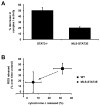Cytoprotection by the modulation of mitochondrial electron transport chain: the emerging role of mitochondrial STAT3
- PMID: 21930250
- PMCID: PMC3278553
- DOI: 10.1016/j.mito.2011.08.011
Cytoprotection by the modulation of mitochondrial electron transport chain: the emerging role of mitochondrial STAT3
Abstract
The down regulation of mitochondrial electron transport is an emerging mechanism of cytoprotective intervention that is effective in pathologic settings such as myocardial ischemia and reperfusion when the continuation of mitochondrial respiration produces reactive oxygen species, mitochondrial calcium overload, and the release of cytochrome c to activate cell death programs. The initial target of deranged electron transport is the mitochondria themselves. In the first part of this review, we describe this concept and summarize different approaches used to regulate mitochondrial respiration by targeting complex I as a proximal site in the electron transport chain (ETC) in order to favor the cytoprotection. The second part of the review highlights the emerging role of signal transducer and activator of transcription 3 (STAT3) in the direct, non-transcriptional regulation of ETC, as an example of a genetic approach to modulate respiration. Recent studies indicate that a pool of STAT3 resides in the mitochondria where it is necessary for the maximal activity of complexes I and II of the electron transport chain (ETC). The overexpression of mitochondrial-targeted STAT3 results in a partial blockade of electron transport at complexes I and II that does not impair mitochondrial membrane potential nor enhance the production of reactive oxygen species (ROS). The targeting of transcriptionally-inactive STAT3 to mitochondria attenuates damage to mitochondria during cell stress, resulting in decreased production of ROS and retention of cytochrome c by mitochondria. The overexpression of STAT3 targeted to mitochondria unveils a novel protective approach mediated by modulation of mitochondrial respiration that is independent of STAT3 transcriptional activity. The limitation of mitochondrial respiration under pathologic circumstances can be approached by activation and overexpression of endogenous signaling mechanisms in addition to pharmacologic means. The regulation of mitochondrial respiration comprises a cardioprotective paradigm to decrease cellular injury during ischemia and reperfusion.
Published by Elsevier B.V.
Figures


Similar articles
-
Mitochondrial-targeted Signal transducer and activator of transcription 3 (STAT3) protects against ischemia-induced changes in the electron transport chain and the generation of reactive oxygen species.J Biol Chem. 2011 Aug 26;286(34):29610-20. doi: 10.1074/jbc.M111.226209. Epub 2011 Jun 29. J Biol Chem. 2011. PMID: 21715323 Free PMC article.
-
Moderate Hydrogen Peroxide Postconditioning Ameliorates Ischemia/Reperfusion Injury in Cardiomyocytes via STAT3-Induced Calcium, ROS, and ATP Homeostasis.Pharmacology. 2021;106(5-6):275-285. doi: 10.1159/000511961. Epub 2020 Dec 10. Pharmacology. 2021. PMID: 33302272
-
Cardioprotective function of mitochondrial-targeted and transcriptionally inactive STAT3 against ischemia and reperfusion injury.Basic Res Cardiol. 2015 Nov;110(6):53. doi: 10.1007/s00395-015-0509-2. Epub 2015 Sep 11. Basic Res Cardiol. 2015. PMID: 26358226
-
Modulation of electron transport protects cardiac mitochondria and decreases myocardial injury during ischemia and reperfusion.Am J Physiol Cell Physiol. 2007 Jan;292(1):C137-47. doi: 10.1152/ajpcell.00270.2006. Epub 2006 Sep 13. Am J Physiol Cell Physiol. 2007. PMID: 16971498 Review.
-
Nitrite mediates cytoprotection after ischemia/reperfusion by modulating mitochondrial function.Basic Res Cardiol. 2009 Mar;104(2):113-9. doi: 10.1007/s00395-009-0009-3. Epub 2009 Feb 26. Basic Res Cardiol. 2009. PMID: 19242636 Review.
Cited by
-
Regulation of innate immune responses by rabies virus.Animal Model Exp Med. 2022 Oct;5(5):418-429. doi: 10.1002/ame2.12273. Epub 2022 Sep 22. Animal Model Exp Med. 2022. PMID: 36138548 Free PMC article. Review.
-
Antitumor activity of phenethyl isothiocyanate in HER2-positive breast cancer models.BMC Med. 2012 Jul 24;10:80. doi: 10.1186/1741-7015-10-80. BMC Med. 2012. PMID: 22824293 Free PMC article.
-
Multi-tasking: nuclear transcription factors with novel roles in the mitochondria.Trends Cell Biol. 2012 Aug;22(8):429-37. doi: 10.1016/j.tcb.2012.05.001. Epub 2012 Jun 14. Trends Cell Biol. 2012. PMID: 22705015 Free PMC article. Review.
-
Nitrate partially inhibits lipopolysaccharide-induced inflammation by maintaining mitochondrial function.J Int Med Res. 2020 Feb;48(2):300060520902605. doi: 10.1177/0300060520902605. J Int Med Res. 2020. PMID: 32043404 Free PMC article.
-
The MEK-ERK pathway is necessary for serine phosphorylation of mitochondrial STAT3 and Ras-mediated transformation.PLoS One. 2013 Nov 29;8(11):e83395. doi: 10.1371/journal.pone.0083395. eCollection 2013. PLoS One. 2013. PMID: 24312439 Free PMC article.
References
-
- Adams JM, Cory S. The Bcl-2 protein family: arbiters of cell survival. Science. 1998;281:1322–1326. - PubMed
-
- Aldakkak M, Stowe DF, Chen Q, Lesnefsky EJ, Camara AK. Inhibited mitochondrial respiration by amobarbital during cardiac ischaemia improves redox state and reduces matrix Ca2+ overload and ROS release. Cardiovasc Res. 2008;77:406–415. - PubMed
-
- Ambrosio G, Zweier JL, Duilio C, Kuppusamy P, Santoro G, Elia PP, Tritto I, Cirillo P, Condorelli M, Chiariello M. Evidence that mitochondrial respiration is a source of potentially toxic oxygen free radicals in intact rabbit hearts subjected to ischemia and reflow. J Biol Chem. 1993;268:18532–18541. - PubMed
-
- Antunes F, Cadenas E. The mechanism of cytochrome C oxidase inhibition by nitric oxide. Front Biosci. 2007;12:975–985. - PubMed
Publication types
MeSH terms
Substances
Grants and funding
LinkOut - more resources
Full Text Sources
Miscellaneous

